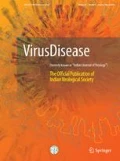Abstract
The present study describes the exploitation of haemadsorption (HAd) property of the Newcastle disease virus (NDV) for the development of a novel sensitive HAd technique based RT-PCR for detection of NDV from clinical samples of virus infected experimental birds. The NDV propagated allantoic fluid from the infected embryonated chicken eggs or supernatant of the processed clinical samples (tissue triturate, cloaca and tracheal swabs) from the experimentally infected birds were added with chicken red blood cells (RBC) to adsorb the virus on RBC’s surface. The virus adsorbed RBCs were subjected to trizol method of RNA extraction and reverse transcription-polymerase chain reaction (RT-PCR) for detection of NDV. The HAd based RNA extraction showed better yield of 700–900 ng RNA and when subjected to RT-PCR detection revealed a 100 times higher sensitivity than the conventional RNA extraction and RT-PCR detection system. This could be an alternate technique which can be exploited in low NDV load situations in clinical samples.

References
Aldous EW, Alexander DJ. Detection and differentiation of Newcastle disease virus (avian paramyxovirus type 1). Avian Pathol. 2001;30:117–28.
Alexander DJ, Manvell RJ, Banks J. Experimental assessment of the pathogenicity of the Newcastle disease viruses from outbreaks in Great Britain in 1997 for chickens and turkeys and the protection afforded by vaccination. Avian Pathol. 1999;28:501–12.
Alexander DJ, Aldous EW, Fuller CM. The long view: a selective review of 40 years of Newcastle disease research. Avian Pathol. 2012;41:329–35.
Chen SY, Wang Y, Telen MJ, Chi JT. The genomic analysis of erythrocyte microRNA expression in sickle cell diseases. PLoS ONE. 2008;3(6):e2360. doi:10.1371/journal.pone.0002360.
Creelan JL, Graham DA, McCullough SJ. Detection and differentiation of pathogenicity of avian paramyxovirus serotype 1 from field cases using one-step reverse transcriptase-polymerase chain reaction. Avian Pathol. 2002;31:493–9.
Desingu PA, Singh SD, Dhama K, Vinodh Kumar OR, Singh R, Singh RK. A rapid method of accurate detection and differentiation of Newcastle disease virus pathotypes by demonstrating multiple bands in degenerate primer based nested RT-PCR. J Virol Methods. 2015;212:47–52.
Dovas CI, Papanastassopoulou M, Georgiadis P, Chatzinasiou E, Maliogka VI, Georgiades GK. Detection and quantification of infectious Avian Influenza A (H5N1) virus in environmental water by using real-time reverse transcription-PCR. Appl Environ Microbiol. 2010;76:2165–74.
Kabanova S, Kleinbongard P, Volkme J, Andree B, Kelm M, Jax TW. Gene expression analysis of human red blood cells. Int J Med Sci. 2009;6:156–9.
Kant A, Koch G, Van Roozelaar DJ, Balk F, Ter Huurne A. Differentiation of virulent and non-virulent strains of Newcastle disease virus within 24 hours by polymerase chain reaction. Avian Pathol. 1997;26:837–49.
OIE. 2012. OIE Terrestrial Manual 2012. Newcastle Disease, Chapter 2.3.14.
Rios M, Daniel S, Chancey C, Hewlett IK, Stramer SL. West Nile virus adheres to human red blood cells in whole blood. Clin Infect Dis. 2007;45:181–6.
Samal SK. Newcastle disease and related avian paramyxoviruses. In: Samal SK, editor. The biology of paramyxoviruses. Norfolk: Caister Academic Press; 2011. p. 69–114.
Toyoda T, Sakaguchi T, Hirota H, Gotoh B, Kuma K, Miyata T, Nagai Y. Newcastle disease virus evolution II. Lack of gene recombination in generating virulent and avirulent strains. Virology. 1989;169:273–82.
Yi J, Liu C. Detecting Newcastle disease virus in combination of RT-PCR with red blood cell absorption. Virol J. 2011;8:202.
Zhang L, Pan Z, Geng S, Chen X, Hu S, Liu H, Wu Y, Jiao X, Liu X. Sensitive, semi-nested RT-PCR amplification of fusion gene sequences for the rapid detection and differentiation of Newcastle disease virus. Res Vet Sci. 2010;89:282–9.
Acknowledgments
The authors are highly thankful to the institute authorities for providing necessary facilities to carry out this research work.
Author information
Authors and Affiliations
Corresponding author
Rights and permissions
About this article
Cite this article
Desingu, P.A., Singh, S.D., Dhama, K. et al. A sensitive haemadsorption technique based RT-PCR for concentration and detection of Newcastle disease virus from clinical samples and allantoic fluid. VirusDis. 27, 319–323 (2016). https://doi.org/10.1007/s13337-016-0325-9
Received:
Accepted:
Published:
Issue Date:
DOI: https://doi.org/10.1007/s13337-016-0325-9

